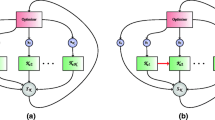Abstract
In this paper we develop a mathematical analysis, based on empirical measurements, of expected average improvements when integrating Machine Learning and Knowledge Acquisition systems in real-life domains. The analysis is based on the characteristics of component systems and combining techniques. Important characteristics include the accuracy of component systems, the degree to which component systems complement each other's weaknesses, and the ability of the combining mechanism to make good choices among competing component systems. Empirical measurements in a real-life application, in the Sendzimir rolling mill, have shown that integrating both approaches enables significant improvements. Improvements when combining systems in two oncological domains were smaller, yet positive again. Analytical average-case integrated models consisting of two systems are introduced. Conditions for improvements over the best, average and the worst system are established and the expected gains are analytically computed based on expected performances. Models strongly suggest that a reasonable integration of two systems offers significant improvements over the best single system in many or even most real-life domains.
Similar content being viewed by others
References
P.T. Baffes and R.J. Mooney, “Extending theory refinement to M-of-N rules,” Informatica, vol. 17–4, pp. 387–399, 1993.
M. Bohanec and V. Rajkovič, “DEX: An expert system shell for decision support,” Sistemica, vol. 1, pp. 145–157, 1991.
P. Brazdil, M. Gams, L. Sian, L. Torgo, and W. van de Velde, “Learning in distributed systems and multi-agent environments,” Proc. of EWSL-91, Porto, Portugal, 1991, pp. 412–424.
W. Buntine, “A theory of learning classification rules,” Ph.D. thesis, Sydney, Australia, 1990.
B. Cestnik and I. Bratko, “On estimating probabilities in tree pruning,” Proc. of EWSL-91, Porto, Portugal, 1991, pp. 138–150.
P. Cheeseman, “On finding the most probable model,” Computational Models of Scientific Discovery and Theory Formation, edited by J. Shrager and P. Langley, Morgan Kaufman, 1991.
W.J. Clancey, “The knowledge level reinterpreted: Modeling how systems interact,” Machine Learning, vol. 4, pp. 285–291, 1989.
P. Clark and T. Niblett, “The CN2 induction algorithm,” Machine Learning, vol. 3–4, 1989.
P. Clark and R. Boswell, “Rule induction with CN2: Some recent improvements,” Proc. of EWSL-91, Porto, Portugal, 1991, pp. 151–163.
E.A. Feigenbaum, “Themes and case studies of knowledge engineering,” Expert Systems in the Microelectronic Age, edited by D. Michie, Edinburgh University Press, 1985.
M. Gams, “New measurements highlight the importance of redundant knowledge,” Proc. of EWSL-89, Montpellier, France, pp. 71–79, 1989.
M. Gams, M. Drobnič, and M. Petkovšek, “Learning from Examples—A uniform view,” International Journal of Man-Machine Studies, vol. 34–1, pp. 49–68, 1991.
M. Gams, M. Bohanec, and B. Cestnik, “A schema for using multiple knowledge,” Computational Learning Theory and Natural Learning Systems, vol. 2, MIT Press, pp. 157–170, 1994.
I.J. Good, The Estimation of Probabilities, MIT Press, 1965.
N. Karba and M. Gams, “Knowledge-based model for constructing integrated knowledge base,” Proc. of the World Congress on Expert Systems, Orlando, Florida, USA, 1991.
N. Karba, “Integrating knowledge bases according to the principle of multiple knowledge,” Ph.D. thesis, Kranj, Slovenia, 1994.
I. Kononenko, “Combining decisions of multiple rules,” Artificial Intelligence V, edited by B. de Boulay and V. Sgurev, North-Holland, pp. 87–96, 1992.
A.L. Kidd, “Knowledge acquisition, an introductory framework,” Knowledge Acquisition for Expert Systems, edited by A.L. Kidd, Plenum Press, pp. 1–16, 1987.
M. Kovačič, “Markovian neural networks,” Biological Cybernetics, vol. 64, 1991.
S.W. Kwok and C. Carter, “Multiple decision trees,” Uncertainty in Artificial Intelligence, vol. 4, pp. 327–335, 1990.
N. Littlestone and M.K. Warmuth, “The weighted majority algorithm,” Technical Report UCSC-CRL-91-28, USA, 1991.
R.S. Michalski, “Machine learning tutorial,” IJCAI'87, Milan, Italy, 1987.
R.S. Michalski, “Inferential theory of learning: Developing foundations of multistrategy learning,” Machine Learning: A Multistrategy Approach, vol. IV, edited by R. Michalski and G. Tecuci, Morgan Kaufmann, pp. 3–61, 1994.
D. Michie, “Methodologies from machine learning in data analysis and software,” Informatica, vol. 17–1, pp. 3–13, 1993.
M. Minsky, “Society of mind: A response to four reviews,” Artificial Intelligence, vol. 48–3, pp. 371–396, 1991.
M. Minsky, “Logical versus analogical or symbolic versus connectionist or neat versus scruffy,” AI Magazine, vol. 12–2, pp. 45–51, 1991.
K. Morik, S. Wrobel, J.U. Kietz, and W. Emde, Knowledge Acquisition and Machine Learning—Theory, Methods and Applications, Academic Press, 1993.
R.S. Mychalski and G. Tecuci (Eds.), Proc. of the Second International Workshop on Multistrategy Learning, Harpers Ferry, USA, 1993.
R. Schapire, “The strength of weak learnability,” Proc. of 21st ACM Symp. of Computing, pp. 28–33, 1989.
G. Tecuci, “Learning as understanding the external world,” Proc. of the First International Workshop on Multistrategy Learning, Harpers Ferry, USA, 1991, pp. 49–65.
T. Urbančič, I. Kononenko, and V. Križman, “AI applications in Slovenia,” Technical Report IJS DP-6183, Jozef Stefan Institute, 1991.
Author information
Authors and Affiliations
Rights and permissions
About this article
Cite this article
Gams, M., Drobnič, M. & Karba, N. Average-case improvements when integrating ML and KA. Appl Intell 6, 87–99 (1996). https://doi.org/10.1007/BF00117810
Issue Date:
DOI: https://doi.org/10.1007/BF00117810




